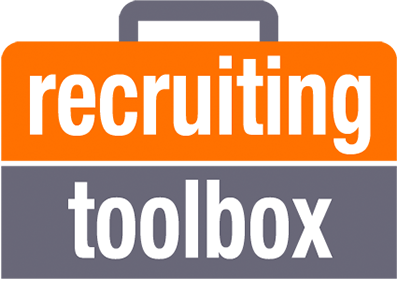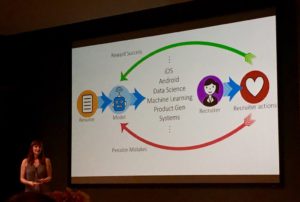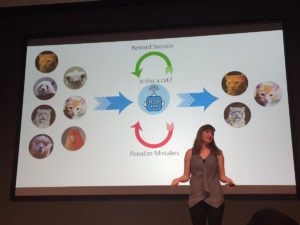Recruiting Toolbox Blog
Building Recruiting Tools for Recruiters at Facebook
Shannon Anderson shares insights from two Facebook hiring managers and engineering leaders who presented at Talent42, the national tech recruiting conference, held in Seattle each June.
Nimrod Hoofien, Engineering Director with Facebook, is working to create the “workplace of the future, through people and recruiting products”. He’s an engaged hiring leader, who is putting machine learning and AI into practice, and thinking about a world where candidate attraction and engagement is powered by data insights and 3.0 tools. Isabel Kloumann is a Data Scientist at Facebook, and together she and Nimrod shared some of their work and vision with us at Talent42 2017.
|
Nimrod Hoofien is an Engineering Director with Facebook
|
Isabel Kloumann is a Data Scientist at Facebook |
Facebook’s incremental value has been constant or rising with every hire
Nimrod opened by sharing this incredible insight, “Facebook now has about 2 billion users. We’ve had huge employee growth, and are achieving a more diverse employee base. This dramatic growth is almost nonsensical. Normally, as a company grows, the incremental value of each person declines until it flattens. But this has not happened to Facebook. Facebook’s incremental value in technology, products and data has been constant or rising with every hire. If we believe in this trend, then it means we should keep hiring more, better, faster. And keep a high hiring bar. Recruiting is a core strategic function at Facebook”.
Recruiting is hard (we knew this)
Nimrod unleashed his technical leadership chops to build recruiting products for Facebook. He says it turns out to be very hard, and becoming harder over time. Why? Referencing Mark Andreesen’s writings since 2011 “Software is Eating the World”, he believes the entire economy will transform to a software function. What this means is the number of software jobs will keep growing, and growing and growing. So far, Nimrod says this is happening almost to the letter of the book (it’s now 2017, 6 years into the original publication of that article). This growth is creating demand that is far exceeding the supply — by a huge margin. There is a headwind at the front — schools cannot meet the demand. Rich talent pools are scattered across Silicon Valley, Seattle, New York, Austin….and we are all fishing in those same ponds. It’s job security for recruiters, but it’s painful.
What technologies are Facebook using today, and what kind of tech should we expect to see in the next 5–10 years?
“Spending time well is the key to being a great recruiter”. Nimrod’s approach is to harness the power of big data, machine learning and artificial intelligence.
The goal is to make the recruiter job:
- Simple — as in easy, removing complexity
- Smart — suggestion based
- Using Science — run experiments, then run test, iterate
“The tenant at Facebook is that Data wins arguments, Code wins arguments. So we use data and code to build things that matter.”
How will these technologies empower hiring managers and tech recruiters?
For example, today a sourcer develops strategies and methodologies that work for him or her and then they “codify” those practices and repeat via heuristics in their head (human intelligence), memory, or maybe a script. And this translates to search strings in their ATS, the web, etc.
This is useful, but we keep going to the same places, the same pools, same search strings, same profiles.
Why is this bad? Competition for one thing. Human brains are horrible at finding one-offs (for example, that hidden rock star dev working in healthcare in Minnesota). But machines don't have any problem finding these folks that are economically nonviable for humans to find.
We also know that people respond to email more on Monday afternoon than Friday afternoon. Data tells us we can draw a curve of response. This is trivial, right? The recruiting team already knows this, but they don’t always leverage this knowledge. Machines can help. How? The recruiter still composes the notes, hits send, but then the machine decides when to transmit based on data. The result at Facebook? 15–20% increase in response.
The key to our recruiting technology at Facebook is that we can automate the collection of data, we can infer meaning from that data, and suggest to the recruiter more efficient ways to recruit. We are not replacing our recruiters with tech. We are just making our recruiters better, smarter, more effective so they can spend more time on critical human things that cannot be automated.
And how will these new tech-enabled insights shape our strategies and impact our recruiting success?
Isabel Kloumann builds the bots. A big focus is fairness and eliminating bias.
Cats give a good example of how Machine Learning trains the system to recognize targets. The data on the left is cat pictures. We initialize an algorithm to give birth to the robot. Then we test cat pictures, plus random junk, then either reward or penalize the system, thus learning occurs. So, to tie this back to recruiting…we train the robot to recognize good potential candidates using human recruiter feedback.
How do we score fairly? Algorithm fairness is Isabel’s specialty. She says AI scores fairly regardless of grouping category or identity). Calibration, Consistency and Clarity are the tenants that drive the machine learning process.
“Bots help us do things better, things we couldn’t do before. We can find less traditional candidates in pockets. Or those buried in the depths of organizations that we can uncover via human power. AI is not perfect, but there is value in bringing hard data and consistency to these questions.”
Summary: AI and ML is not a magic bullet. Science is about observing and measuring, then responding. The secret sauce lies in the sheer quantity and scale of data that can be leveraged for the Machine Learning bots to get trained. Machine learning shines at scale problems: the more data, the better. Bring it.
If you liked this article please share it on FB, Twitter, etc
follow me at @ShannAnder
Shannon L Anderson is a Principal Consultant with Recruiting Toolbox. She draws from over 25 years of talent acquisition, executive search and leadership experience, including 14 years as a corporate recruiting practitioner at Microsoft and Ignition. She loves to solve unique talent challenges presented by companies at progressive inflection points.





